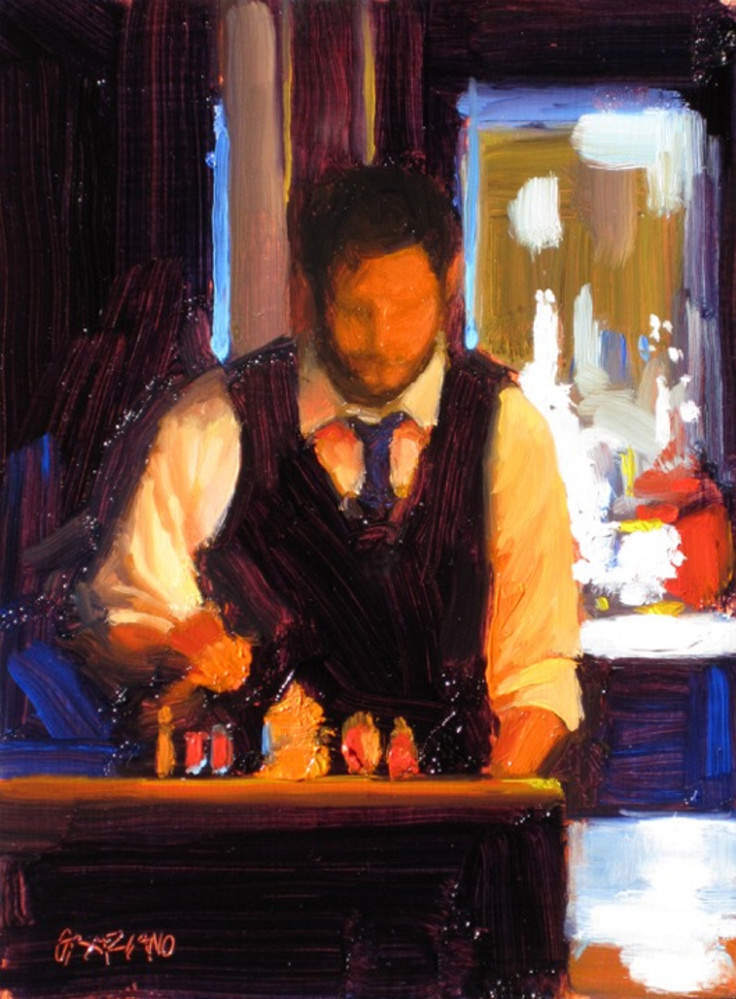In Dan Graziano’s imagination, a restaurant kitchen looks something like a dance floor, where chefs engage in a nightly ballet with the waiters and waitresses, sometimes the diners and always the food.
“It’s a carefully staged dance,” Graziano said. “They work quickly, and there’s a lot of intensity in what they’re doing. It’s very dramatic.”
An oil painter from Castine, Graziano enjoys dining with his wife, Kristin Blanck. They request a table near the kitchen, so they can see the action, and they especially like dining at restaurants with an open view to the kitchen.
If the food itself is a form of artistic expression, the activity of the chefs who design, create and present the food is performance art. Graziano is interested in the kitchen action that makes Portland’s food scene interesting and exciting.
Over Thanksgiving, Graziano and Poland photographer Michael McAllister spent two days in a half-dozen Portland restaurants, taking photos in the kitchen and on the floor. They capped their research with a meal at the Grill Room. Using the photos as source material, Graziano made two dozen oil paintings from his experience. They hang this month at Roux & Cyr International Fine Art Gallery on Free Street in Portland. In March, the gallery will show McAllister’s photos.
Gallery owner Susan Roux suggested the exhibition after she showed a series of paintings that Graziano made of the restaurant scene in Charleston, South Carolina, where he and his wife enjoy spending time. Like Portland, Charleston has a thriving dining culture, with many outdoor cafes on tree-lined streets that are splashed with sunlight.
Roux sold several of Graziano’s paintings from South Carolina, and suggested he work up paintings from Portland. She timed the exhibitions with Maine Restaurant Week, which begins later this month.
“People love to watch other people cooking,” Roux said. “It’s part of the experience of dining out these days. It’s a spectator sport.”
Graziano’s paintings are full of action: Cooks shucking oysters, flambeing over an open flame and arranging bread for baking. There are paintings of waiters in white aprons delivering trays of food and bartenders mixing drinks. There are still-lifes of a napkin-and-silverware setting and a bottle of brown liquor, filtering incoming light.
From a painterly perspective, Graziano is attracted to restaurants for the same reasons he likes painting harbor scenes and boats back home in Castine: They challenge him with their shifting shapes, the fluid way the light moves through the scene and the rush of human activity. These aren’t portraits – recognition is suggested by a hat or bandana – but paintings of men and women in action. Graziano treats his subjects as studies of the human figure, paying attention to their movements, the shapes of the pots and pans, the color of their clothes and the fixed angles of the hard kitchen surfaces. His paintings reflect heat and energy.
They also reflect calm. One of Graziano’s favorites shows a man at the end of the coffee bar at Starbucks, gazing out the window with his chin in one hand. A newspaper is spread in front of him, with a cup coffee. Graziano calls the painting “Gone But I Don’t Know Where.”
Graziano and McAllister included eight restaurants in their research: Street & Co., David’s, Bull Feeney’s, Boone’s, Nosh and the Grill Room, Corner Room and Front Room. On his own, Graziano went to Harbor Fish Market and Starbucks on Congress Street, across from the Portland Museum of Art.
They spent a few hours at each restaurant, staying out of the way on the edge of the action. They were less interested in documenting the action than in capturing moments of activity, tension and resolve.
The smallest paintings in the show, less than a foot tall and a few inches wide, sell for $700. The largest, 24-by-30 inches, cost $2,800. There are 29 paintings, including a few from Charleston.
Cathy Gore, manager at Street & Co., said the restaurant gave the two full access, asking only that they not set up lights or tripods. “They kept to themselves. We actually hardly noticed they were here.” Gore said.
She recognized one of her cooks on the poster that Roux & Cyr is using to promote the show.
Laura Geftick, manager at Bull Feeney’s, enjoyed having the artists in the restaurant. They showed up in the morning to observe the prep work, then returned during the evening to watch the kitchen in full swing. It felt oddly rewarding being the object of an artist’s scrutiny, Geftick said. “I’m glad we can be an inspiration.”
Send questions/comments to the editors.





Success. Please wait for the page to reload. If the page does not reload within 5 seconds, please refresh the page.
Enter your email and password to access comments.
Hi, to comment on stories you must . This profile is in addition to your subscription and website login.
Already have a commenting profile? .
Invalid username/password.
Please check your email to confirm and complete your registration.
Only subscribers are eligible to post comments. Please subscribe or login first for digital access. Here’s why.
Use the form below to reset your password. When you've submitted your account email, we will send an email with a reset code.